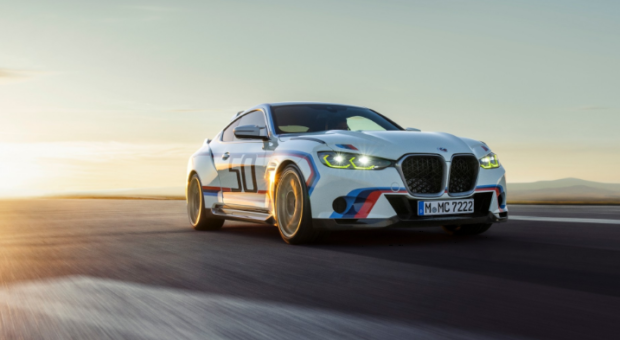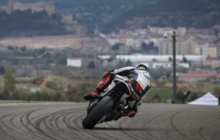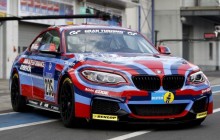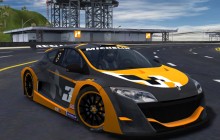
The BMW 3.0 CSL (fuel consumption combined: 11.0 l/100 km; CO2 emissions combined: 249 g/km according to WLTP; details according to NEDC: – ) combines a unique design with a puristic performance experience in two seats. It conveys to the present day in an extremely focused manner the concept created in the 1970s of applying racetrack technology designed for sheer driving pleasure on the road.
The BMW 3.0 CSL was developed with the intention of combining the best of five decades of racing expertise from BMW M GmbH in an automobile with a highly emotional aura. All facets of its character – dynamic exterior elegance, a classic sportscar cockpit, intelligent lightweight construction, a straight six-cylinder engine, manual transmission and rear-wheel drive – are based on traditional principles of a BMW M automobile. They complement each other with the help of the latest technology to create the ultimate symbol of fascination for top performance in the style of the brand that has been successful for 50 years. A ride in a BMW 3.0 CSL is therefore not only an exclusive high-performance experience, but also an emotional encounter with the history and the present of the world’s most powerful letter.
The BMW 3.0 CSL as a limited production run incorporating elaborate craftsmanship.
The BMW 3.0 CSL is produced in a strictly limited edition. To mark the anniversary, exactly 50 consecutively numbered units of the special model will go on sale. Right from the start, this gives the BMW 3.0 CSL the status of a rarity that will find its place in the vehicle collections of particularly loyal and enthusiastic fans of the BMW M brand.
The production of all vehicles will take around three months. Each and every one of them is created with absolute dedication to excellence in craftsmanship and precisely coordinated technologies in an elaborate manufacturing process at the external location of the BMW Group Dingolfing plant in Moosthenning, Lower Bavaria. The exclusive interior carbon fibre reinforced plastic (CFRP) components are produced by hand both in Munich and at the BMW Group component factory in Landshut by specially assigned bodywork specialists.
A specific process was also conceived for the paintwork of the BMW 3.0 CSL, in which craftsmanship and state-of-the-art technology complement each other to provide each individual part with its characteristic colour design. In addition, a team of 30 specially qualified and experienced technicians is responsible for the configuration and assembly of the vehicles. Due to the complexity of the processes in the manufactory, each BMW 3.0 CSL passes through eight assembly cycles at just as many production stations, a procedure that takes up to 10 days in all.
All in all, the extremely high proportion of individual manual work means that the time required to assemble a BMW 3.0 CSL is many times higher than that of a conventional BMW M automobile. After completion in the manufactory, each vehicle also undergoes a multi-stage quality inspection and approval process at the main Dingolfing plant before it is released for delivery to the customer. The BMW Group Plant Dingolfing is the company’s largest European production site. In addition to several BMW M automobiles, the luxury sedans of the BMW 7 Series and body components for Rolls-Royce Motor Cars are produced there.
The successful touring car – a role model in its time.
As the reincarnation of a legendary sports car both for the racetrack and the road, the BMW 3.0 CSL possesses all the characteristics of a puristic car. It embodies the joy of classic driving and an awareness of the traditional roots of BMW M GmbH in a uniquely exclusive form. Its eponymous role model is considered the first automobile to carry the DNA for maximum driving pleasure and passion, an unmistakeable feature of BMW M automobiles to this very day. In the founding year of BMW Motorsport GmbH, it was developed for use in touring car competitions, where it became the most successful racing car of its era.
The racing version of the historic BMW 3.0 CSL won the European Touring Car Championship during its inaugural season in 1973 – and repeated this title win five more times in succession from 1975 to 1979. Drivers such as Toine Hezemans, Hans-Joachim Stuck, Chris Amon and Niki Lauda left the competition behind at the Nürburgring and numerous other circuits, followed by BMW’s first victories on US circuits as early as 1975. All these successes helped the works racing cars to gain international popularity.
“Coupe, Sport, Lightweight construction“: New interpretation of a legendary formula.
The road version of the racing car, which was developed for homologation purposes, became a widely known symbol of inspiring driving pleasure focused on the essentials, especially in its final stage of development. CSL – this combination of letters in the model designation stood for “Coupé, Sport, Leichtbau” (Coupe, Sport, Lightweight), a concise summary of the two-door car’s recipe for success.
In addition to wide wheel arches, its coupe-shaped body also received an eye-catching aerodynamics package, which included a front spoiler, air bars on the front side panels and a roof spoiler. Completing the design modifications vs. the other coupes in BMW large series was a rear wing that optimised the grip of the rear wheels. It was not approved for road use and therefore lay in the boot when the vehicle was delivered, but nevertheless received much public attention so that the Coupe was given the nickname “Batmobile”.
With an increased displacement of 3,153 cubic centimetres and a maximum output of 151 kW/206 hp, the most powerful straight six-cylinder engine with direct injection ever used in a BMW model ensured sporty power delivery. The powerful drive system was combined with refined suspension technology. Its unladen weight was just 1,270 kilograms.
The reduced weight was achieved through comprehensive lightweight construction. The doors were made of aluminium, as were the bonnet and the boot lid, which were supported on filigree retaining rods after opening. Numerous other body components such as the roof, side panels and luggage compartment partition were made of particularly thin sheet metal, and the chrome bumpers were replaced by plastic skirting. Lightweight bucket seats and the omission of insulation material, power steering and electric windows ensured optimal weight reduction. An overall power-to-weight ratio of 6.2 kilograms per horsepower was thus achieved.
The new BMW 3.0 CSL is the contemporary reinterpretation of all these features anchored in its model designation. Its coupe-shaped body sets traditional accents for sporty elegance and expressive dynamics. Its drive and suspension technology stems from the latest developments for racing cars and high-performance sports cars from BMW M GmbH. And the intelligent lightweight construction reaches an outstanding level, above all through the extensive use of carbon. The power-to-weight ratio of the BMW 3.0 CSL is a mere 2.9 kilograms per hp.
As an independent model from BMW M GmbH and despite the limited number of units, the BMW 3.0 CSL has undergone a complete series development process. In addition to the extensive quality and function tests and the driving dynamics tuning test drives under a wide range of conditions from city traffic to country roads and motorways to the race track, the BMW 3.0 CSL has also undergone comprehensive aerodynamic testing. Around 200 working hours were spent on optimising the airflow and aerodynamic balance of the vehicle, including 50 hours in the wind tunnel of the BMW Group’s Aerodynamic Test Centre. In addition, two pre-production vehicles of the BMW 3.0 CSL had to undergo a safety test in the form of a frontal and a side crash test in order to meet road legal requirements.
Unique, M-typical design, geared to the technical demands of fascinating performance.
With its classic coupe proportions and a traditional vehicle concept that combines a front engine and manual transmission with rear-wheel drive, the BMW 3.0 CSL follows in the footsteps of its historic ancestor. Distinctive air deflection elements, powerfully shaped wheel arches, a striking rear spoiler and numerous other details are unmistakably based on the design of the legendary coupe from the 1970s.
At the same time, its appearance is characterised by the principles that have always applied to BMW M automobiles: The specific exterior features are based on the technical requirements in terms of cooling air supply, aerodynamic balance and driving dynamics, which form the basis for highly fascinating performance. In this way, the BMW 3.0 CSL expresses timeless racing passion in an emotional and authentic way.
Powerful aesthetics pay tribute to the historical ancestor.
Power and athleticism are signalised by the front end of the BMW 3.0 CSL, which sits low on the road. At its centre is the distinctive BMW kidney grille with a lattice-shaped insert in a diamond structure. Its upright position relates to the front design of its historic ancestor. Like the side window surrounds, the kidney frame is finished in satin aluminium – a design feature that emphasises the special status of the BMW 3.0 CSL. Together with the BMW kidney grille, two generously dimensioned recesses in the front apron, reminiscent of the air intakes on the 1970s model, ensure reliable cooling of the drive and brake systems even in extremely dynamic driving situations. Sculpturally shaped air fins on the bonnet accentuate the classic lines.
With their flat contours, the headlights create the characteristic focus on the road. The BMW Laser Light headlights shine in yellow, both during the welcome scenario after unlocking the doors and when the low and high beams are activated, thus making reference to successful GT racing cars. This detail is a subtle reference to the strong connection with motorsport and BMW M GmbH’s currently most successful competition vehicle, the BMW M4 GT3, which won both the drivers’ and team championships in the DTM in 2022 and whose power unit is based on the same straight-six engine as the power unit of the BMW 3.0 CSL. The BMW M4 GT3 achieved championship success right at the start of its racetrack career, much like the historic BMW 3.0 CSL, which once won the European Touring Car Championship in its inaugural season.
Viewed from the side, the long bonnet and wide wheelbase lend the BMW 3.0 CSL an appearance that is both sporty and classically elegant. The brand-typical coupe proportions in a three-box design also contribute to this. Particularly wide, diagonally offset side panels and wide side walls underline the dynamic appearance of the coupe even when stationary, with an air deflector extending along the roof line.
Wide wheel arches, central locking wheels produced exclusively for the BMW 3.0 CSL’s tyres.
Muscular wheel arches give indication of the large track widths that contribute significantly to the vehicle’s high cornering dynamics. They offer space for the forged light-alloy wheels in a Y-spoke design, these being 20 inches on the front axle and 21 inches at the rear. With their filigree spokes, a gold-coloured paint finish in the style of the 1970s and a centre lock, they represent a highlight in terms of design and driving dynamics adapted directly from racing. The integration of the model-specific wheels into the pre-assembled axles of the BMW 3.0 CSL is part of the manufacturing process at the BMW Group’s Dingolfing plant. At 930 Nm, the torque applied during the assembly of the centre locks achieves the highest value for a BMW Group production vehicle.
The forged light-alloy wheels are fitted with Michelin tyres developed exclusively for the BMW 3.0 CSL. They bear the number 50 embossed on the tyre sidewalls, providing another subtle reference to the anniversary of BMW M GmbH, on the occasion of which the special model was designed and built.
Source: BMW





